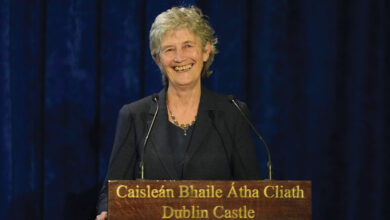Phil Flanagan MLA
 Phil Flanagan, from Garrison, is one of three Sinn Féin MLAs for Fermanagh and South Tyrone. A former mobile phone shop owner, he was co-opted to Fermanagh District Council for Erne West in October 2009 and elected to Stormont in May 2011. He stood down from his council seat last August, and currently sits on the Enterprise, Trade and Investment Committee and Education Committee.
Phil Flanagan, from Garrison, is one of three Sinn Féin MLAs for Fermanagh and South Tyrone. A former mobile phone shop owner, he was co-opted to Fermanagh District Council for Erne West in October 2009 and elected to Stormont in May 2011. He stood down from his council seat last August, and currently sits on the Enterprise, Trade and Investment Committee and Education Committee.
What led you into politics?
I suppose the desire to bring about an end to inequality and discrimination has been the primary driver of my political activism. Being a proud Fermanagh man, the fact that rural communities are often completely neglected has often exercised me and this is an issue I am very vocal on and am keen to address. As a border dweller, I see day and daily the negative impact that the partition of my country has on people’s lives and as long as that division continues, then inequality and discrimination will continue. Whilst discrimination is no longer as obvious as it once was, it still very much exists; it is just more discreet nowadays.
Why Sinn Féin?
Sinn Féin are the only political party serious about driving change in Irish life. From my perspective, other parties are full of individuals serving their own narrow agenda who often have a vested interest in retaining the status quo. I firmly believe that every single member of Sinn Féin is involved in the party for the greater good, to deliver an Ireland that is just, is fair and serves all the citizens of this country.
What do you consider to be your three main achievements since being elected?
Since my election last May, I have worked tirelessly on behalf of the people of Fermanagh and South Tyrone by campaigning to reverse the historic under-investment in both strategic infrastructure and employment in this constituency. This is very clearly evidenced by the massive gaps in public transport, the fact that many areas still cannot access mobile phone coverage or broadband and by the fact that the area receives little support for its tourism product, despite it being world-renowned for its beautiful natural environment.
I have worked very hard to change this, but it is not something that can be resolved in twelve months. It will take much longer than that and I am committed to it. In terms of shorter-term projects, I have put the issue of fracking firmly on the agenda within the Assembly, secured a direct bus link from Enniskillen to Derry and am currently working on ways to protect our townlands heritage.
Going forward, what are your main aims to achieve before the next Assembly election?
The recently published Programme for Government sets out the key priorities for the Executive for the next few years. Personally, I would like to see greater emphasis on creating a low carbon future, with cheaper energy from sustainable sources for citizens and for businesses.
High priority is given to job creation within the PfG and rightly so, but as an MLA for a rural constituency, I am keen to ensure that the investment is fairly spread out and that the trend of directing everything into greater Belfast does not continue. People are abandoning rural areas and the rural way of life because of a lack of job opportunities, gaps in telecommunications infrastructure, poor roads and public transport network and the high cost of fuel.
Reversing this trend and enabling people to live in their own rural community is a key objective of mine. Many, many young people are also being forced to emigrate from this island as a result of the recession and the lack of job opportunities, so creating hope and meaningful employment for our citizens has to be a key priority for any elected representative in the current economic climate.
 What does a shared future in Fermanagh and South Tyrone mean to you?
What does a shared future in Fermanagh and South Tyrone mean to you?
The economic cost of division is not as great in my constituency as it is in some others. Whereas in parts of Belfast you would see two leisure centres or libraries in close proximity to separately serve both sides of the community, there are only three of each in the whole of Fermanagh, so we do not have the same luxury to be divided.
There currently exists a great relationship between the majority of people in this constituency. People from all backgrounds take part in a wide range of sporting activities together. Protestants openly participate in Gaelic football whilst Catholics make up a large section of the soccer fraternity, and each are made very welcome into the sporting organisations.
What is more obvious in my constituency would be the existence of several towns or villages with nearly 100 per cent of the population coming from one section of the community or the other. If, as a society, we are to develop a truly shared future, then it has to be one based on equality, understanding and respect, not simply on tolerating each other. If history has taught us anything, it is that discrimination breeds resentment and division.
How do you spend your free time?
My wife has just given birth to our second daughter, so any free time that I have is spent with my family, although that isn’t much to be honest. Driving to and from Stormont itself takes 16 hours out of my week, let alone all the other travelling an MLA must do across a massive constituency like mine and the actual lengthy hours we spend in Stormont. So I have very little free time, which is difficult for a man with a young family.
When I stood for election, I said being an MLA didn’t suit a retired person. It appears it doesn’t suit a young person with a family either, so I’m still trying to figure out who it does suit. If I had more free time, I would like to go back to playing Gaelic football and see if I could manage to lose a few pounds that way.





